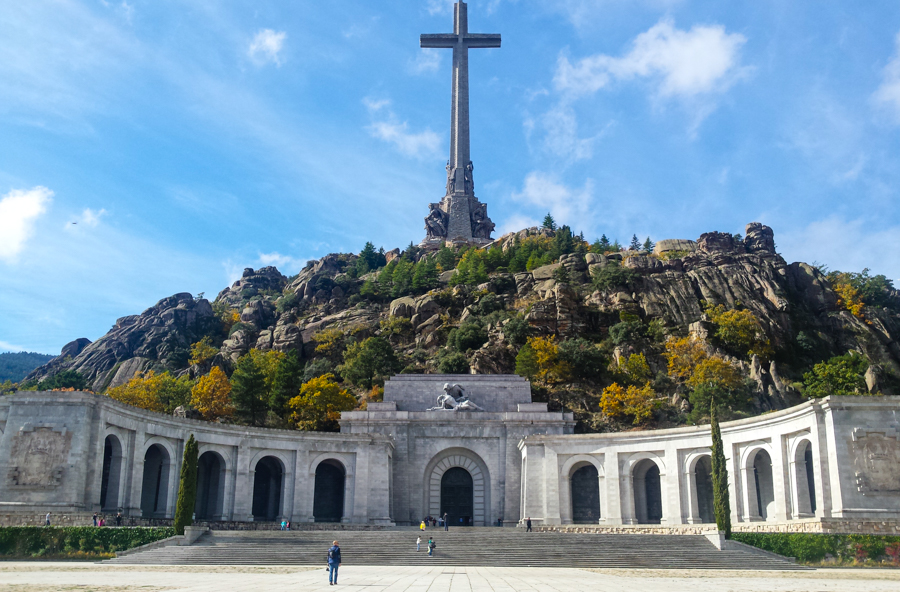
Entrance to the Valley of the Fallen and the cross, at 150 meters high and overlooks the monument.
Built between 1940 and 1958, the Valley of the Fallen is a monument that impresses with its size and history.
It is part of the recent history of Spain and even today continues to generate controversy. There are differences that still divide some Spaniards, in their religious beliefs, politics and morals. The monument belongs to the National Heritage, as it was paid for with money from the state and not with church money. But it is an eminently religious building and has a Benedictine abbey.
The historical context of its construction
The Civil War began on July 18, 1936, after the military uprising against the democratic government of the Republic. The war, that ended in 1939, cost the lives of an estimated 300,000-500,000 people (exact figures are still unknown and often disputed).
The aim of the rebels (self-styled ‘National Party’) was to restore the monarchy and fight against communism and against the anticlericalism of the Republican Left. After the victory of General Franco, he was elected as Head of State, Chief of the Army and head of government.
In 1939 the postwar period began, with a strong economic crisis, jails full of political prisoners and a divided nation. A year later, in 1940, Franco issued the construction project of a monument to the “Fallen by God and Spain”. That year the work on the Valley of the Fallen began on the outskirts of El Escorial.
The symbolism of the location and its architecture
The choice of location is highly symbolic. The Sierra de Guadarrama has historically been home to the Kings of Spain, with the royal palaces of Riofrio, Valsain, La Granja and El Escorial. In addition, the hill where the monument “Risco de la Nava” sits is at 1400m, making it visible from kilometers away. As if this were not enough, the cross stands at 150m, a truly impressive building and an effective propaganda tool.
When Franco spoke of the Civil War he used the term “Crusade”, the Nationals regarded their defeated enemies as the “anti-Spanish” and they considered his work as a crusade in defense of the Catholic Faith. In this context Franco chose the symbolism of the monument, a large cross crowning the mountain on which a crypt would hold the fallen.
The Basilica
A large forecourt leads to the Crypt, know today as a Basilica. From this forecourt the main, porticoed facade is in granite, in a style that mimics the “herreriano” rebirth of El Escorial, with its symbolic connotations of the great empire of Felipe II.
Also, from the forecourt we can appreciate the size of the cross, at 150 metres tall it’s the largest cross in Christianity. It has at its base gigantic sculptures of the four evangelists (Saint Juan, Saint Lucas, Saint Mateo and Saint Marcos) and the four cardinal virtues (prudence, justice, fortitude and temperance).
Once inside, from the porch, we have a unique view of the nave, a long, dark and dank cave, which tries to imitate the roof rock of the mountain. On both sides of this nave we have the chapels dedicated to different invocations of the Virgin, with large bas-reliefs. In each chapel we find a neo-Gothic triptych depicting the life of Mary and Jesus. There are also a total of 12 sculptures of alabaster of the twelve Apostles (two in each chapel).
The eight tapestries from the nave represent the Apocalypse, and can be read from right to left. These are a copy of the entrusted in the sixteenth century by Philip II in Brussels. The originals are now in the Granja de San Ildefonso, because of damages due to the humidity.
As we get closer we come across eight impressive sculptures, covered with a veil. They represent the army (holding a sword), navy (with an anchor), Air Force (with a propeller) and militias (with the symbolism of the Falange, the yoke and arrows).
In the transept stands the main altar, with a large untreated wooden cross, which was made with a tree handpicked by Franco in the surrounding mountains. There are also sculptures of the four archangels Gabriel, Michael, Raphael and Azrael, the latter is covered with a veil and with his hands in the air, since it was responsible for bringing souls to God’s presence. At the foot of the altar are the tombs of Franco and Jose Antonio Primo de Rivera (founder of the Falange). (Updated: Franco is no longer in the Valley of the Fallen since October 24th 2019).
The dome of the altar is a golden mosaic depicting Christ and the fallen, as well as saints and martyrs.
On both sides of the main altar is the Chapel of the Blessed Sacrament and the Chapel of the Sepulchre, which gives access to the galleries where the fallen of the Civil War are buried.
The Fallen during the Civil War
In the Valley of the Fallen lie 33,847 people who lost their lives during the Civil War. The bodies were transferred from 1958 from their original graves, from all over the Spanish territory, both Nationals and Republicans, with or without the permission of their families. Some of these bodies are still unidentified.
Francisco Franco and Jose Antonio Primo de Rivera are also buried here, although neither died during the war.
For these circumstances, today some relatives of the deceased ask their bodies to moved to other places.
Practical information for visit the Valley of the Fallen:
- Schedules and prices: National Heritage Website
- We organize guided tours and can combine a visit to El Escorial and Valley of the Fallen.


